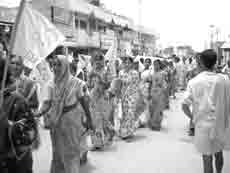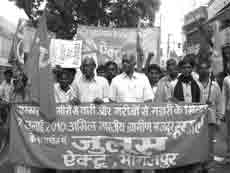WORKING CLASS
All India Rural Workers’ Strike
Rajiv Dimri
For the very first time in India, rural workers as a class organised themselves for a synchronised protest across the country on 7 July 2010. 
In this strike, the rural workers asserted their right for Rs 200 wage for 200 days, kerosene and ration for Rs 2, ten decimal homestead land, immediate changes in the BPL categorisation and automatic inclusion of all agricultural labourers, marginal and small peasantry, artisans and contract workers who are employed in government schemes-campaigns for an honorarium, like Asha and anganwadi workers. A special relief package from Central government in view of the sky rocketing prices and reduction in fuel prices and essential commodities were part of the key slogans around which AIALA organised the rural poor. In areas where corruption and loot in the panchayats became an issue, the participation saw manifold qualitative difference in the militancy of the protests. In several places, contract workers participated enthusiastically. Women were present in large numbers and added a militant dimension to the assertion of the rural workforce. The strike brought together the urban poor with the rural poor in a new way. Across the country, in solidarity with the strike, CPIML units, AICCTU, AIPWA and other organisations of the urban poor and government employees participated in dharnas and burnt effigies of the central and state governments.
Campaign in Industrial Zone in Jharkhand Supporting the Strike
A weeklong campaign from 1-7 July took place in the industrial zone of three districts of Dhanbad, Bokaro and Ramgarh in Jharkhand organised by Central Coal Mines Workers’ Union (CMWU), Jharkhand General Workers’ Union, All India Central Council of Trade Union’s (AICCTU) and the CPI(ML) to mobilise industrial workers to support the 7 July strike call by rural and agricultural workers, and to oppose the proposed ten percent disinvestment in the coal sector as well as the petroleum price hike.
During this week, various joint meetings and gatherings of coal workers and rural workers were held in the BCCL-12 area, Mugma, Govindpur etc. in Dhanbad between 1-5 July. Panchayat level conventions were held at several places in Ramgarh district– Ara, Sandi, Orla, Chumba and Gungri under Mandu block; Bartua, Tirri, Hehal, Paki and Jogo panchayats in Patratu block; and in two panchayats of Ramgarh and Gola block. At Kathara coal mine area of Central Coalfields Limited in Bokaro district, one thousand leaflets were distributed among the organised coal workers. Campaign also took place among the rural workers of Bermo, Gomia and Chandankiyari. Finally, on 5 July a Workers’ Convention was organised at Kathara in which, apart from many workers, various local leaders and HMS union leaders also participated. Comrades Sukhdeo Prasad, Baleshwar Gope and DK Mistry addressed this convention and appealed to the coal workers to come out in full support of the 7 July strike called by AIALA.
Apart from the above initiatives, cycle rallies, marches, solidarity meetings etc. were held in almost every panchayat in Ramgarh district and attended by 1000-1500 rural and industrial workers respectively. Dharnas were also held at some block headquarters such as Chandankiyari and Bermo in Bokaro district. In these dharnas dozens of women and men from many villages participated; in one of them 50 from one village alone. A long march covering several miles was held from Petarwar to Jaridih participated mostly by the local rural and urban workers, led by Comrade Parmeshwar Mahato. |
The strike was led by AIALA in 3000 panchayats of 250 districts in 16 states, while the propaganda and campaign for it was carried out in 6000 panchayats. Intensive propaganda preceded the strike in all places with street meetings, rallies, marches and on the day of the strike direct participation of 5 lakh rural workers was observed, with several more lakhs involved and influenced by the strike and its campaign.
Unorganised Women Workers Join the Struggle
In addition to agrarian labourers, various other sections of rural workers also participated in the 7 July action with their own specific demands. One such instance was a couple of demonstrations – one by ASHAs and another by female cooks for mid-day meals in schools – at the Polba-Dadpur Block Development Office in Hoogly district.
Preparations for the joint programmes had been taken up both at the mass political level and the administrative level. Our work among these two strata has been initiated only a few months ago; there is no mass organization yet for them; we are yet to develop even a single party member from among them; and there is a lot of resistance from the CPI (M). In such circumstances we (as AIPWA organizers) had to concentrate, in our preparatory group discussions, with both ASHAs and midday meal cooks on their own specific demands and then link up with the overall perspective of the 7 July all-India strike. This evoked a very good response from both sections and a total of 85 women participated in the programme. The figure would have been much higher were it not for transport disruption on that day.
At the administrative level, we had met the BDO and officially informed her in writing about the purposes of our deputations. So the BDO asked the concerned officials (the BMOH in the case of ASHA and the supervisor of the mid-day meal project) to be present during the deputations. On our part we came with sufficient homework, equipped with relevant papers like government circulars, copy of our charter of demands placed earlier before the concerned minister, etc.
So, with ASHAs and the cooks under AIPWA banner continuing the joint demonstrations outside, the two deputations took place one by one. Both were led by AIPWA State Secretary Chaitali Sen, who is organizing these workers in the district, and each lasted for about one-and-a-half hours. The charters were discussed and debated point by point. Demands that could be settled at the block level were conceded, such as arranging police escort when an “ASHA didi” takes a pregnant woman to a hospital at night, providing sitting arrangements for them at health centres and sub-centres, the mid-day meal supervisor to take action whenever a cook faces humiliation or payment irregularities at schools. Regarding other demands like pay rise, the BDO promised to forward these to higher authorities for sympathetic consideration.
This small endeavour of developing a new stream of women’s movement on the soil of class struggle added a special dimension to the experience of the rural strike. After the programme AIPWA is getting new contacts and finds itself in a better position to bring the mass of rural women closer to the Party.
Chaitali Sen |
In Bihar, the strike was successfully held in all 38 districts. In districts like Bhojpur, Rohtas, Buxar, Patna, Jehanabad, Arwal, Nalanda, Siwan, Darbhanga,Gopalganj, Champaran, Samastipur, Darbhanga, Muzzafarpur and Gaya the strike was complete. In 1500 panchayats the strike was successfully carried out with the participation of 2 lakh rural workers. In several villages of Bhojpur, Patna and Champaran, a wage strike has succeeded the 7 July strike. In Bhojpur, in solidarity with the rural workers’ strike a successful Bandh was imposed in Ara town. In Patna, Bhagalpur and other cities, protest marches and unity marches of rural and urban poor were taken out by CPIML, RYA, AICCTU and AIPWA along with urban unorganised workers and poor. 
In Jharkhand, in 198 panchayats of 56 blocks and 15 districts, the strike was implemented successfully with the participation of more than 31,000 people. In Uttar Pradesh, in 16 districts, 70 blocks, 15,000 people implemented the strike. In both these states, NREGA work was boycotted and machine-managed mud cutting operation were disrupted.
In Tamil Nadu, systematic plans were taken up to implement the strike. Complete strike was carried out in 75 panchayats wherein 15,000 workers participated. In several places the workers had to confront and clash with the administration and police to implement the strike. In 200 panchayats, the campaign for the strike was organised effectively. The state AICCTU played an outstanding role in ensuring the success of the strike. 
In Karnataka, 17 panchayats saw successful implementation of the strike: in two panchayats of Gangawati, 10 panchayats of Harpanahalli and in five panchayats of Heggadadevanakote. More than 200 people were mobilised in each place.
In Andhra Pradesh, intensive campaign was carried out in 200 panchayats. The strike was successfully carried out in 39 panchayats of 17 mandals, with mass picketing in district headquarters of East Godavari, Krishna, Ananthapur, West Godavari, Khammam and Vishakapatnam with more than 15000 people participating in it. Three district headquarters also saw demonstrations in solidarity of the strike. Two hundred people were arrested in Yeleshwaram in confrontation with police, while implementing the strike. In Orissa despite the pouring rain, the strike was effectively implemented in 40 panchayats of 10 districts. Several important roads were blocked by the rural workers to highlight the issues. In Puducherry campaign and propaganda for the strike was carried out.
In West Bengal, in 13 districts intensive propaganda through mike meetings, street meetings, and massive leafleting preceded the 7 July strike. It was most effective in Nadia, Bankura, Burdhaman and six other districts. In Hooghly, panchayat offices were locked up and bus workers stopped plying in solidarity with the strike. Fifty panchayats saw effective shut downs in the state with the participation of 13,000 rural workers. In Bankura at three block headquarters demonstration of workers was enthused by strikers who had walked more than 30 kilometres to reach the spot. In Nadia bidi workers gave memorandum and strike was called in the labour markets.
The 7th July All-India Rural Strike in Hooghly District
The district committees of the Party and the Krishi Majoor Samity made comprehensive plans to make the 7th July strike of the rural workers a success. While there were various initiatives on a wider scale involving the six blocks of the district, and intensive propaganda was organised at the grassroots level in some of the panchayats. The panchayats where large-scale propaganda was carried out were: 7 panchayats in Pundooah block, 5 panchayats in Dhaniakhali block, 5 panchayats in Polba-Dadpur block, 4 panchayats in Balaghar block, 2 panchayats in Magra block and 1 panchayat in the Singur block. The forms of propaganda undertaken were posters, wall-writing, distribution of leaflets, meetings at the village level, rallies and mike-meetings from van rickshaws.
On the day of the strike, more than hundred agrarian and other rural workers assembled before the Belmuri gram panchyat office and put it under lock and key. As the rural workers were agitating before the Jair-Darbasini panchyat office after locking it, the CPI(M) mobilised some drunken lumpen elements who tried to attack and terrorise the agitating workers. The striking rural workers put up a brave resistance and repulsed the attack.
The workers however did not give up their initiative as soon as the 7th July strike was made a success. From the very next day, movements were organised for wage increase and these were successful in increasing the wages to some extent.
Prabir Halder |
In Tripura strike was observed in 6 panchayats of two blocks with picketing in other places of work. 50 workers were arrested in Kailashpur for blocking major roads passing through the villages. In Assam, gheraos were held in three blocks of Dibrugarh and Jorhat districts. The highway was blocked by the rural workers to highlight their issues. In Nawagon gherao of the district headquarters in Koliawar subdivision was effectively carried out. In Tinsukhia, Kamrup, Sonitpur districts effective ghearaos were organised and memorandums submitted. 
In Karbi Anglong, intensive propaganda preceded the strike. On 7 July rallies, were held in Hamren, Diphu and Bokajan. Memorandum was submitted to the President, PrimeMinister and the Governor demanding a CBI enquiry into the 3000 crore scam by the ruling Congress supported organisation in Karbi Anglong. Corruption in NREGA featured a key mobilising point in the autonomous district. 
In Punjab, in 17 blocks of seven districts, including Muktsar, Firozpur, Moga, Mansa, Sangrur and Barnala, the strike was effectively implemented with 2000 people participating. In Uttrakhand, effigies of the State and Central governments were burnt and memorandum submitted in Dharchula and Munsiyari of Pithorgagarh districts, Siyalde of Almora district and Srinagar of Pauri Garwal district. The AIKM played a key role in the campaign for the strike in Uttarakhand. In Chattisgarh, the rural workers emphasised their presence and asserted in Bastar, Bilaspur, Durg and Raipur. In Rajasthan, in 13 villages of Piral and Jhunjhunu the strike was effectively implemented. Madhya Pradesh, Kerala, and Haryana also organised campaigns for the implementation of the strike.
The first all India strike of the rural workers has effectively carried the message that in the coming days this large force will rise with still greater preparation to confront the governments pro-rich policies. CPIML and AIALA have resolved to organise and strengthen this potent force of rural workers in the coming days.



